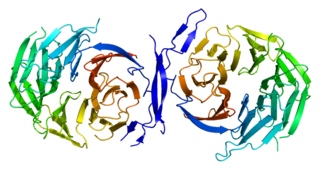
PER2 is a protein in mammals encoded by the PER2 gene. PER2 is noted for its major role in circadian rhythms.

Deleted in azoospermia-like is a protein that in humans is encoded by the DAZL gene.

Frizzled-9(Fz-9) is a protein that in humans is encoded by the FZD9 gene. Fz-9 has also been designated as CD349.

Deleted in azoospermia 1, also known as DAZ1, is a protein which in humans is encoded by the DAZ1 gene.

MutS protein homolog 5 is a protein that in humans is encoded by the MSH5 gene.

Suppressor of SWI4 1 homolog is a protein that in humans is encoded by the PPAN gene.

MutS protein homolog 4 is a protein that in humans is encoded by the MSH4 gene.

Transducin-like enhancer protein 3 is a protein that in humans is encoded by the TLE3 gene.

Polyhomeotic-like protein 2 is a protein that in humans is encoded by the PHC2 gene.

DNA mismatch repair protein Mlh3 is a protein that in humans is encoded by the MLH3 gene.

Single-minded homolog 1, also known as class E basic helix-loop-helix protein 14 (bHLHe14), is a protein that in humans is encoded by the SIM1 gene.

Protein boule-like is a protein that in humans is encoded by the BOLL gene.

Fanconi anemia, complementation group I (FANCI) also known as KIAA1794, is a protein which in humans is encoded by the FANCI gene. Mutations in the FANCI gene are known to cause Fanconi anemia.

Achaete-scute complex homolog 2 (Drosophila), also known as ASCL2, is an imprinted human gene.

In molecular biology, Enhancer of rudimentary homolog is a protein that in humans is encoded by the ERH gene.

Serine/threonine-protein kinase MAK is an enzyme that in humans is encoded by the MAK gene.

Transducin-like enhancer protein 4 is a protein that in humans is encoded by the TLE4 gene.

Transcription factor HIVEP3 is a protein that in humans is encoded by the HIVEP3 gene.

BTB domain containing 9 is a protein that in humans is encoded by the BTBD9 gene.

Nanos homolog 1 (Drosophila) is a protein that in humans is encoded by the NANOS1 gene.



















